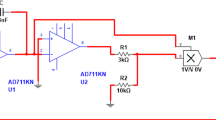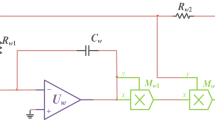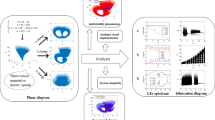Abstract
In this paper, a new four-dimensional (4D) memristive system is presented by introducing a memristor equation to a 3D chaotic system. Firstly, the basic characteristics including existence and stability of equilibrium points, and Kaplan–Yoke dimension for the memristive system are analyzed from a theoretical perspective. The description of the 4D memristive system in the integer-order and the fractional-order cases is given. In both cases, the dynamics with the variation of a system parameter or a derivative order is studied by the numerical simulations. The results show that the integer-order and the fractional-order memristive systems have rich dynamics. Secondly, in order to realize the synchronization for the memristive system, two adaptive synchronization schemes are designed, namely, the identical structure and the different structure synchronization. Numerical simulation results show that the designed synchronization controllers are effective. Finally, a novel image encryption algorithm is expanded to the image encryption for color images based on the memristive system. The simulation results demonstrate the image encryption method based on the memristive system has a perfect encryption effect for the color images.













Similar content being viewed by others
Data availability
The datasets generated and analyzed during the current study are available from the corresponding author on reasonable request.
References
Zhou C, Wang CH, Yao W (2023) Quasi-synchronization of stochastic memristive neural networks subject to deception attacks. Nonlinear Dyn 111:2443–2462
Wang LJ, Yan QS (2022) Exact synchronization and asymptotic synchronization for linear ODEs. Sci China Math 65:1163–1178
Guan JB, Wang KH (2015) Sliding mode control and modified generalized projective synchronization of a new fractional-order chaotic system. Math Probl Eng 2015:941654
Hua ZY, Zhu ZH, Chen YY, Li YM (2021) Color image encryption using orthogonal Latin squares and a new 2D chaotic system. Nonlinear Dyn 104:4505–4522
Zhu LY, Jiang DH, Ni JQ, Wang XY, Rong XW, Ahmad M, Chen YP (2022) A stable meaningful image encryption scheme using the newly-designed 2d discrete fractional-order chaotic map and bayesian compressive sensing. Signal Process 195:108489
Can E, Uyaroglu Y (2015) A new seven-term chaotic attractor and its hyperchaos. Optoelectro Adv Mat 9:777–781
Zhang JG, Chu YD, Du WJ, Chang YX, An XL (2014) Hopf bifurcation analysis in a new chaotic system with chaos entanglement function. J Appl Math 2014:371509
Lai Q, Chen SM (2016) Coexisting attractors generated from a new 4D smooth chaotic system. Int J Control Autom 14:1124–1131
Vaidyanathan S, Sambas A, Mamat M, Sanjaya WSM (2017) A new three-dimensional chaotic system with a hidden attractor, circuit design and application in wireless mobile robot. Arch Control Sci 27:541–554
Guan ZH, Lai Q, Chi M, Cheng XM, Liu F (2014) Analysis of a new three-dimensional system with multiple chaotic attractors. Nonlinear Dyn 75:331–343
Gong LH, Luo HX, Wu RQ, Zhou NR (2022) New 4D chaotic system with hidden attractors and self-excited attractors and its application in image encryption based on RNG. Physica A 591:126793
Zou DY, Li M, Li J, Li ZG (2021) An image encryption algorithm based on a new hybrid power exponent chaotic system. Secur Commun Netw 2021:7580971
Lin H, Wang C, Hong Q, Sun Y (2020) A multi-stable memristor and its application in a neural network. IEEE Trans Circuits Syst Express Briefs 67:3472–3476
Dong Z, He Y, Hu X, Qi D, Duan S (2019) Flexible memristor-based LUC and its network integration for Boolean logic implementation. IET Nanodielectr 2:61–69
Shaarawy N, Emara A, El-Naggar AM, Elbtity ME, Ghoneima M, Radwan AG (2018) Design and analysis of 2T2M hybrid CMOS-Memristor based RRAM. Microelectron J 73:75–85
Njitacke Z, Fotsin H, Negou AN, Tchiotsop D (2016) Coexistence of multiple attractors and crisis route to chaos in a novel memristive diode bidge-based Jerk circuit. Chaos Soliton Frac 91:180–197
Messadi M, Kemih K, Moysis L, Volos C (2023) A new 4D memristor chaotic system: analysis and implementation. Integration 88:91–100
Sun JW, Zhao XT, Fang J, Wang YF (2018) Autonomous memristor chaotic systems of infinite chaotic attractors and circuitry realization. Nonlinear Dyn 94:2879–2887
Peng YX, He SB, Sun KH (2021) A higher dimensional chaotic map with discrete memristor. AEU-In J Electron C 129:153539
Sun JW, Han GY, Wang YF, Zhang H, Wu L (2018) Hybrid memristor chaotic system. J Nanoelectro Optoe 13(6):812–818
Deng QL, Wang CH, Sun JR, Sun YC, Jiang JG, Lin HR, Deng ZK (2024) Nonvolatile CMOS memristor, reconfigurable array, and its application in power load forecasting. IEEE Trans Industr Inf 20(4):6130–6141
Lin HR, Wang CH, Sun YC (2024) A universal variable extension method for designing multiscroll/wing chaotic systems. IEEE Trans Industr Electron 71(7):7806–7818
Tang D, Wang CH, Lin HR, Yu F (2024) Dynamics analysis and hardware implementation of multi-scroll hyperchaotic hidden attractors based on locally active memristive hopfield neural network. Nonlinear Dyn 112:1511–1527
Deng QL, Wang CH, Lin HR (2024) Memristive Hopfield neural network dynamics with heterogeneous activation functions and its application. Chaos, Solitons Fractals 178:114387
Lai Q, Kamdem Kuate PD, Pei HQ, Fotsin H (2020) Infinitely many coexisting attractors in no-equilibrium chaotic system. Complexity 2020:8175639
Wan QZ, Zhou ZT, Ji WK, Wang CH, Yu F (2020) Dynamic analysis and circuit realization of a novel no-equilibrium 5D memristive hyperchaotic system with hidden extreme multistability. Complexity 2020:7106861
Ramamoorthy R, Rajagopal K, Leutcho GD, Krejcar O, Namazi H, Hussain I (2022) Multistable dynamics and control of a new 4D memristive chaotic Sprott B system. Chaos Soliton Frac 156:111834
Zhu LY, Jiang DH, Ni JQ, Wang XY, Rong XW, Musheer A, Chen YP (2022) A stable meaningful image encryption scheme using the newly-designed 2D discrete fractional-order chaotic map and Bayesian compressive sensing. Signal Process 195:108489
Toktas A, Erkan U, Gao S, Pak C (2024) A robust bit-level image encryption based on Bessel map. Appl Math Comput 462:128340
Cheng L (2002) The synchronization and circuit implement for chaotic and hypechaotic systems. Northeast Normal University, Master’s thesis. (In Chinese).
Trentelman HL, Stoorvogel AA, Hautus M (2012) Control theory for linear systems. Springer Science & Business Media, Berlin, Germany
Petráš I (2011) Fractional-order nonlinear systems: modeling, analysis and simulation. Higher Education Press, Bei**g
Podlubny I (1999) Fractional differential equations. Academic Press, San Diego
Hairer E, Nørsett SP, Wanner G (1993) Solving ordinary differential equations I: nonstiff problems, 2nd edn. Springer-Verlag, Berlin
Hairer E, Wanner G (1991) Solving ordinary differential equations II: stiff and differential-algebraic problems. Springer-Verlag, Berlin
Diethelm K, Ford NJ, Freed AD (2002) A predictor-corrector approach for the numerical solution of fractional differential equations. Nonlinear Dyn 29:3–22
Charef A, Sun HH, Tsao YY, Onaral B (1992) Fractal system as represented by singularity function. IEEE Trans Autom Control 37:1465–1470
Wang T, Song LW, Wang MH, Zhuang ZB (2020) A novel image encryption algorithm based on parameter-control scroll chaotic attractors. IEEE Access 8:36281–36292
Çelik H, Doğan N (2024) A hybrid color image encryption method based on extended logistic map. Multimed Tools Appl 83:12627–12650
Arpacı B, Kurt E, Celik K (2020) A new algorithm for the colored image encryption via the modified Chua’s circuit. Eng Sci Technol Int J 23:595–604
Firdous A, urRehman A, SaadMissen MM (2019) A highly efficient color image encryption based on linear transformation using chaos theory and SHA-2. Multimed Tools Appl 78:24809–24835
Parvaz R, Yengejeh YK, Behroo Y (2022) A new 4D chaos system with an encryption algorithm for color and grayscale images. Int J Bifurcat Chaos 32:2250214
Chai X, Bi J, Gan Z et al (2020) Color image compression and encryption scheme based on compressive sensing and double random encryption strategy. Signal Process 176:107684
Funding
This study was funded by the National Natural Science Foundation of Shaanxi province (No. 2023-JC-YB-075) and the Natural Science Preparatory Study Foundation of **’an University of Posts and Telecommunications (No.106/205020030).
Author information
Authors and Affiliations
Contributions
Funding acquisition, investigation, writing, and original draft preparation by **aojun Liu; software, data analysis, and formal analysis by Pu Wang; methodology, writing, and editing by Dafeng Tang and **g Tian.
Corresponding author
Ethics declarations
Code availability
The code will be made available on request.
Conflict of interest
The authors declare that they have no known competing financial interests or personal relationships that could have appeared to influence the work reported in this paper.
Rights and permissions
Springer Nature or its licensor (e.g. a society or other partner) holds exclusive rights to this article under a publishing agreement with the author(s) or other rightsholder(s); author self-archiving of the accepted manuscript version of this article is solely governed by the terms of such publishing agreement and applicable law.
About this article
Cite this article
Liu, X., Wang, P., Tang, D. et al. A new four-dimensional memristive system, synchronization and its application in image encryption. Int. J. Dynam. Control (2024). https://doi.org/10.1007/s40435-024-01464-x
Received:
Revised:
Accepted:
Published:
DOI: https://doi.org/10.1007/s40435-024-01464-x




